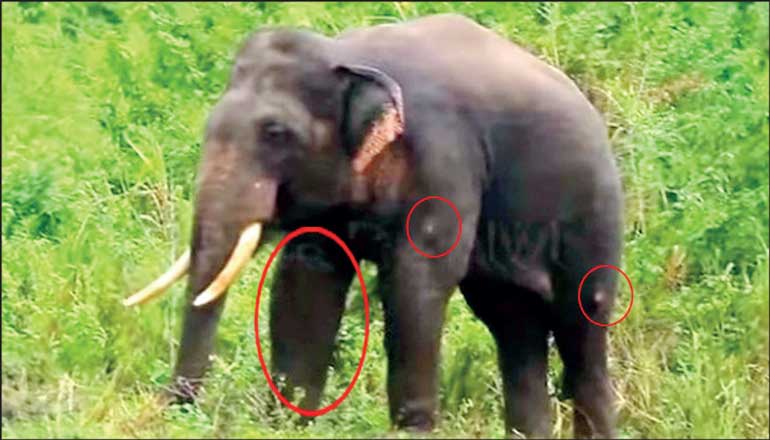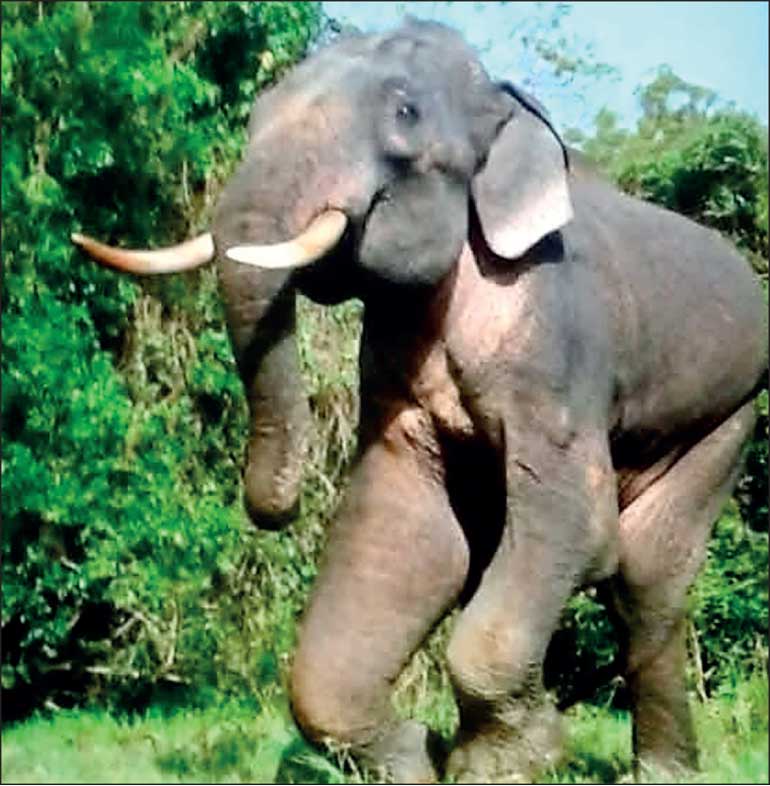Thursday Oct 02, 2025
Thursday Oct 02, 2025
Saturday, 16 August 2025 00:10 - - {{hitsCtrl.values.hits}}

Bhathiya was sighted carrying several gunshot wounds – Pic credit: Saranga Deva de Alwis
Treatment being administered
 On 15 July, the wild elephant known as Bhathiya succumbed to multiple injuries it had sustained in the wild. It had been shot at and wounded in early May. During early July, its injuries had worsened, and it had been treated by wildlife department veterinarians.
On 15 July, the wild elephant known as Bhathiya succumbed to multiple injuries it had sustained in the wild. It had been shot at and wounded in early May. During early July, its injuries had worsened, and it had been treated by wildlife department veterinarians.
During this time, there was a media frenzy going on, with politicians ‘basking’ in the suffering that the poor animal was going through, armchair elephant SM experts giving advice and updates, and the wildlife officials scrambling to do damage control. It was almost like a choreographed social media performance that was being staged to a pathetic, gullible public, who were lapping up what was dished out with great interest.
The earth had hardly received the body of this gentle giant when social media began overflowing with emotional, knee-jerk, grandiose rhetoric. Slogans of ‘Return their land to them’ and ‘Save the Elephants’ resonate, and petitions are being prepared. The pathetic response from the ‘wise men’ in the Government is to bring more legislation – 19 new protected areas, ‘tightening’ laws related to shooting of elephants, new laws about setting up illegal electric fences, setting up an elephant hospital, etc.
Why can’t everyone understand that the problem is in the implementation, not in the legislation?
In Sri Lanka, killing (or injuring/harming) a wild elephant is explicitly classified as a non-bailable offence under the Fauna and Flora Protection (Amendment) Act, No. 22 of 2009. Here’s what the law states: Any offence involving an elephant under this act — including using electric wire or other devices to kill, injure an elephant — is punishable by a high fine and/or imprisonment.
“The fault, dear Brutus, lies not in our stars, but in ourselves,” — Julius Caesar, Act I, Scene II
Mark my words: in a few months, Bhathiya will be forgotten, and the media will move, like vultures, to another ‘carcass’ to feed on.
That is why we need to take a deeper look into the events that led to this magnificent animal’s death and what we can learn from it. What is required is not emotional outbursts but pragmatic solutions that can be quickly implemented to somehow mitigate this carnage.
Let’s not kid ourselves. This complex human-elephant conflict can never be fully eradicated. It can only be managed and mitigated by strategically and systemically implementing interventions to reduce the crisis selectively, in identified hot spots. Such interventions must be based on good applied scientific research, which is readily available.
Bhathiya’s injuries and eventual death
Bhathiya was a full-grown male wild elephant with majestic tusks from the North Central Province of Sri Lanka. He was in the prime of his life and was probably around 30 years old, and was a popular figure among wildlife photographers.
He was known to periodically trespass into villages and carried many injuries as a result of gunshot wounds. Most villagers use locally made illegal firearms which shoot pellets rather than proper bullets. These pellets do not penetrate deep into an elephant’s skin unless they are fired at close range or hit a sensitive area where the skin is thin. They get embedded inside the skin and, although they may not cause any immediate threat, some of these wounds fester over time. This is mostly evident in the legs of elephants, which start swelling up, making it difficult for the animal to walk.

Bhathiya was no exception, and he carried his share of ‘pellets’ on his body. But, apparently, amidst these superficial injuries, there were one or two more serious ones which eventually became life-threatening.
The sequence of events
(The following is based on careful analysis of the press conferences of the DWC and Dept. of Veterinary Science in Peradeniya, and other first-hand information received from sources.)
Issues to be noted
1.It appears that proper assessment of the seriousness of the injuries was not carried out early.
2.Consequently, proper intensive treatment may have been delayed.
3.Considering the seriousness of the situation, the request for external help should have been expedited.
4.The bringing down of foreign experts also has had considerable bureaucratic hurdles to clear.
5.In any event, by this time it was evident to the elephant would not recover from such traumatic injuries.
Facts
1.Lack of acceptance that the Sri Lankan wild elephant is a national asset to be protected at all costs.
2.The DWC is woefully short-staffed in the area of veterinary support with only 15 veterinarians on their staff.
3.Most of them are relatively young and do not have good practical field experience.
4.Treating wild elephants is a complex task and requires years of on-field experience under the apprenticeship of experts.
5.The DWC also lacks the necessary resources to respond quickly to treat wild animals in the field.
6.Often some of the injuries elephants sustain are untreatable, and one can only wait until death releases them from suffering.
7.We profess to be a ‘Buddhist country’, but we do grievously harm to innocent animals, while euthanasia is forbidden.
8.There is an alarming increase in injuries to wild elephants at the hands of villagers and poachers, with some areas showing a greater incidence of such altercations.
9.The HEC issue is quite complex to solve, and geographically wide-spread but with several identified hot spots.
A pragmatic solution as a pilot project (to mitigate the problem in the short term only)
1.Establish a Presidential task force with all powers to administer and execute a pilot project (“Hastii Punajeevanay”) in a selected area where the HEC problem is serious (possibly the north-western province).
2.The task force will constantly monitor and direct all activities of the special units described below.
3.Undertake a quick baseline survey of all the areas where wild elephants are usually sighted, where altercations have taken place, past data of injuries and deaths, and farming locations.
4.Prepare a data base of all iconic tuskers in the area who are known for crop raiding and closely and consistently monitor their movements (by word-of-mouth information supported by technology wherever possible e.g. radio collaring).
5.Set up two rapid response mobile veterinarian units dedicated to the area, on standby 24 x 7 hours, with fully equipped four-wheel drive vehicles with all necessary medical equipment, communication facilities etc.
6.These units will respond to all reports related to injuries to elephants in the area immediately.
7.Set up two or three enforcement units, supported by police, for constant patrolling of the province.
8.They will systematically inspect villages for unlawful electric fencing and also conduct search operations for firearms and prosecute wrongdoers accordingly.
9.Immediately recruit at least 10 new veterinarians to the DWC.
10.Invite several foreign veterinarians with good practical expertise in wild elephant treatment to conduct a two-week field training program for the Sri Lankan veterinarians.
Outcomes
1.Review after six months to ascertain if there is a reduction in incidents.
2.If successful endeavour to roll out to other hot spots also.
3.Carefully record and review all interactions for future learnings.